Mehwish Alam
IP Paris
Two-dimensional Taxonomy for N-ary Knowledge Representation Learning Methods
Jun 05, 2025Abstract:Real-world knowledge can take various forms, including structured, semi-structured, and unstructured data. Among these, knowledge graphs are a form of structured human knowledge that integrate heterogeneous data sources into structured representations but typically reduce complex n-ary relations to simple triples, thereby losing higher-order relational details. In contrast, hypergraphs naturally represent n-ary relations with hyperedges, which directly connect multiple entities together. Yet hypergraph representation learning often overlooks entity roles in hyperedges, limiting the fine-grained semantic modelling. To address these issues, knowledge hypergraphs and hyper-relational knowledge graphs combine the advantages of knowledge graphs and hypergraphs to better capture the complex structures and role-specific semantics of real-world knowledge. This survey provides a comprehensive review of methods handling n-ary relational data, covering both knowledge hypergraphs and hyper-relational knowledge graphs literatures. We propose a two-dimensional taxonomy: the first dimension categorises models based on their methodology, i.e., translation-based models, tensor factorisation-based models, deep neural network-based models, logic rules-based models, and hyperedge expansion-based models. The second dimension classifies models according to their awareness of entity roles and positions in n-ary relations, dividing them into aware-less, position-aware, and role-aware approaches. Finally, we discuss existing datasets, negative sampling strategies, and outline open challenges to inspire future research.
Markov Process-Based Graph Convolutional Networks for Entity Classification in Knowledge Graphs
Dec 23, 2024

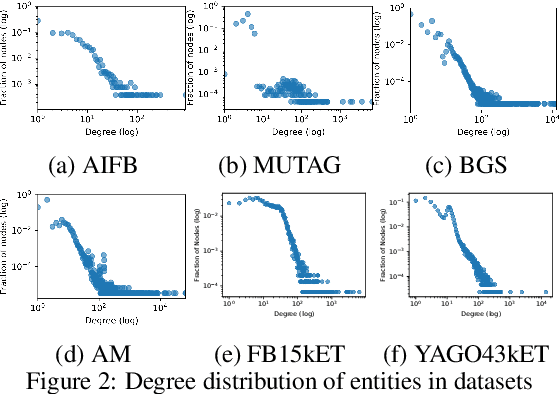

Abstract:Despite the vast amount of information encoded in Knowledge Graphs (KGs), information about the class affiliation of entities remains often incomplete. Graph Convolutional Networks (GCNs) have been shown to be effective predictors of complete information about the class affiliation of entities in KGs. However, these models do not learn the class affiliation of entities in KGs incorporating the complexity of the task, which negatively affects the models prediction capabilities. To address this problem, we introduce a Markov process-based architecture into well-known GCN architectures. This end-to-end network learns the prediction of class affiliation of entities in KGs within a Markov process. The number of computational steps is learned during training using a geometric distribution. At the same time, the loss function combines insights from the field of evidential learning. The experiments show a performance improvement over existing models in several studied architectures and datasets. Based on the chosen hyperparameters for the geometric distribution, the expected number of computation steps can be adjusted to improve efficiency and accuracy during training.
Neurosymbolic Methods for Dynamic Knowledge Graphs
Sep 06, 2024Abstract:Knowledge graphs (KGs) have recently been used for many tools and applications, making them rich resources in structured format. However, in the real world, KGs grow due to the additions of new knowledge in the form of entities and relations, making these KGs dynamic. This chapter formally defines several types of dynamic KGs and summarizes how these KGs can be represented. Additionally, many neurosymbolic methods have been proposed for learning representations over static KGs for several tasks such as KG completion and entity alignment. This chapter further focuses on neurosymbolic methods for dynamic KGs with or without temporal information. More specifically, it provides an insight into neurosymbolic methods for dynamic (temporal or non-temporal) KG completion and entity alignment tasks. It further discusses the challenges of current approaches and provides some future directions.
Refining Wikidata Taxonomy using Large Language Models
Sep 06, 2024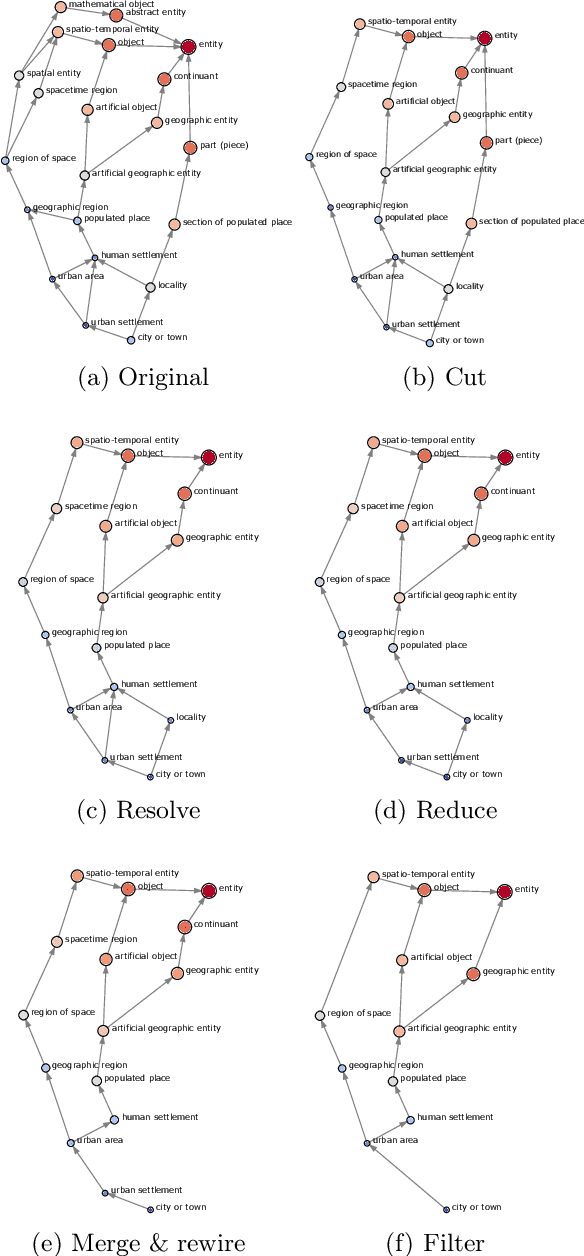
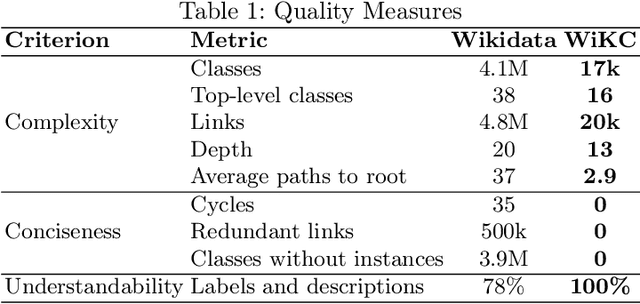

Abstract:Due to its collaborative nature, Wikidata is known to have a complex taxonomy, with recurrent issues like the ambiguity between instances and classes, the inaccuracy of some taxonomic paths, the presence of cycles, and the high level of redundancy across classes. Manual efforts to clean up this taxonomy are time-consuming and prone to errors or subjective decisions. We present WiKC, a new version of Wikidata taxonomy cleaned automatically using a combination of Large Language Models (LLMs) and graph mining techniques. Operations on the taxonomy, such as cutting links or merging classes, are performed with the help of zero-shot prompting on an open-source LLM. The quality of the refined taxonomy is evaluated from both intrinsic and extrinsic perspectives, on a task of entity typing for the latter, showing the practical interest of WiKC.
Neurosymbolic Methods for Rule Mining
Aug 11, 2024

Abstract:In this chapter, we address the problem of rule mining, beginning with essential background information, including measures of rule quality. We then explore various rule mining methodologies, categorized into three groups: inductive logic programming, path sampling and generalization, and linear programming. Following this, we delve into neurosymbolic methods, covering topics such as the integration of deep learning with rules, the use of embeddings for rule learning, and the application of large language models in rule learning.
NeMig -- A Bilingual News Collection and Knowledge Graph about Migration
Sep 01, 2023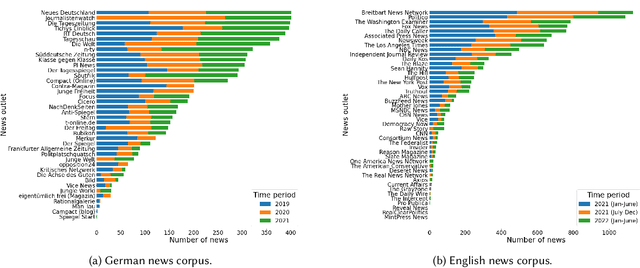

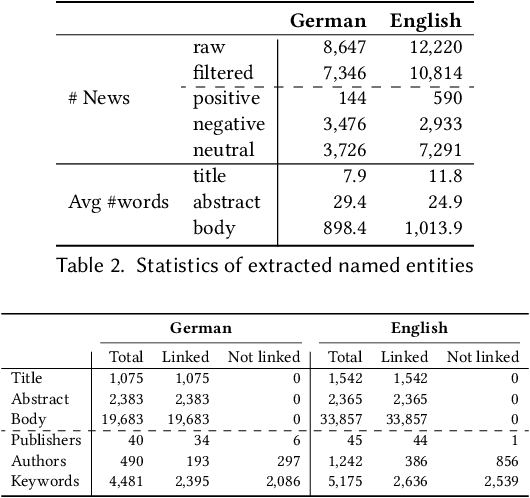
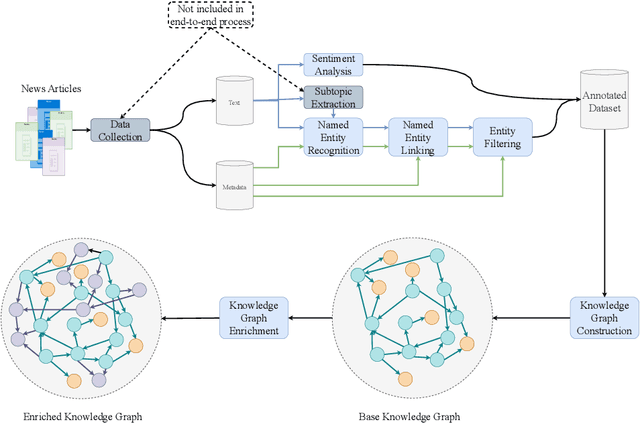
Abstract:News recommendation plays a critical role in shaping the public's worldviews through the way in which it filters and disseminates information about different topics. Given the crucial impact that media plays in opinion formation, especially for sensitive topics, understanding the effects of personalized recommendation beyond accuracy has become essential in today's digital society. In this work, we present NeMig, a bilingual news collection on the topic of migration, and corresponding rich user data. In comparison to existing news recommendation datasets, which comprise a large variety of monolingual news, NeMig covers articles on a single controversial topic, published in both Germany and the US. We annotate the sentiment polarization of the articles and the political leanings of the media outlets, in addition to extracting subtopics and named entities disambiguated through Wikidata. These features can be used to analyze the effects of algorithmic news curation beyond accuracy-based performance, such as recommender biases and the creation of filter bubbles. We construct domain-specific knowledge graphs from the news text and metadata, thus encoding knowledge-level connections between articles. Importantly, while existing datasets include only click behavior, we collect user socio-demographic and political information in addition to explicit click feedback. We demonstrate the utility of NeMig through experiments on the tasks of news recommenders benchmarking, analysis of biases in recommenders, and news trends analysis. NeMig aims to provide a useful resource for the news recommendation community and to foster interdisciplinary research into the multidimensional effects of algorithmic news curation.
Integrating the Wikidata Taxonomy into YAGO
Aug 23, 2023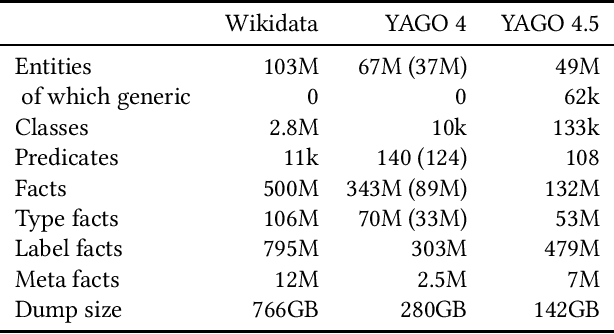
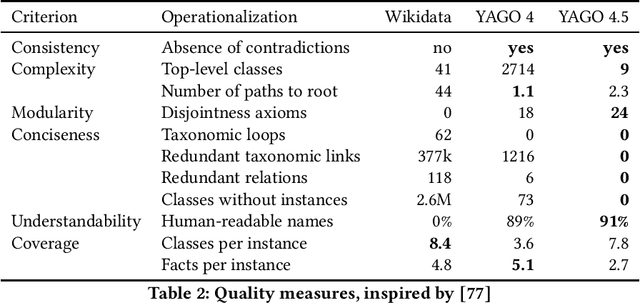

Abstract:Wikidata is one of the largest public general-purpose Knowledge Bases (KBs). Yet, due to its collaborative nature, its schema and taxonomy have become convoluted. For the YAGO 4 KB, we combined Wikidata with the ontology from Schema.org, which reduced and cleaned up the taxonomy and constraints and made it possible to run automated reasoners on the data. However, it also cut away large parts of the Wikidata taxonomy. In this paper, we present our effort to merge the entire Wikidata taxonomy into the YAGO KB as much as possible. We pay particular attention to logical constraints and a careful distinction of classes and instances. Our work creates YAGO 4.5, which adds a rich layer of informative classes to YAGO, while at the same time keeping the KB logically consistent.
Towards Semantically Enriched Embeddings for Knowledge Graph Completion
Aug 02, 2023Abstract:Embedding based Knowledge Graph (KG) Completion has gained much attention over the past few years. Most of the current algorithms consider a KG as a multidirectional labeled graph and lack the ability to capture the semantics underlying the schematic information. In a separate development, a vast amount of information has been captured within the Large Language Models (LLMs) which has revolutionized the field of Artificial Intelligence. KGs could benefit from these LLMs and vice versa. This vision paper discusses the existing algorithms for KG completion based on the variations for generating KG embeddings. It starts with discussing various KG completion algorithms such as transductive and inductive link prediction and entity type prediction algorithms. It then moves on to the algorithms utilizing type information within the KGs, LLMs, and finally to algorithms capturing the semantics represented in different description logic axioms. We conclude the paper with a critical reflection on the current state of work in the community and give recommendations for future directions.
RAILD: Towards Leveraging Relation Features for Inductive Link Prediction In Knowledge Graphs
Nov 21, 2022Abstract:Due to the open world assumption, Knowledge Graphs (KGs) are never complete. In order to address this issue, various Link Prediction (LP) methods are proposed so far. Some of these methods are inductive LP models which are capable of learning representations for entities not seen during training. However, to the best of our knowledge, none of the existing inductive LP models focus on learning representations for unseen relations. In this work, a novel Relation Aware Inductive Link preDiction (RAILD) is proposed for KG completion which learns representations for both unseen entities and unseen relations. In addition to leveraging textual literals associated with both entities and relations by employing language models, RAILD also introduces a novel graph-based approach to generate features for relations. Experiments are conducted with different existing and newly created challenging benchmark datasets and the results indicate that RAILD leads to performance improvement over the state-of-the-art models. Moreover, since there are no existing inductive LP models which learn representations for unseen relations, we have created our own baselines and the results obtained with RAILD also outperform these baselines.
Entity Type Prediction Leveraging Graph Walks and Entity Descriptions
Jul 29, 2022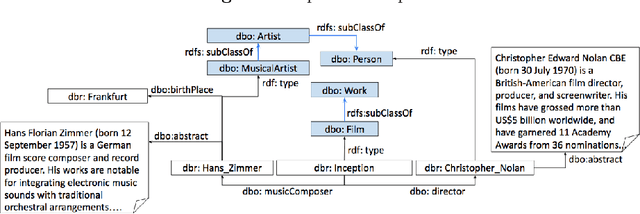

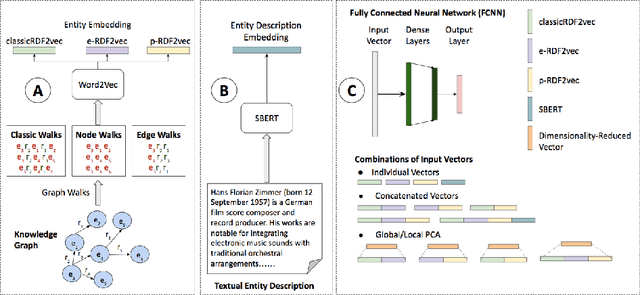
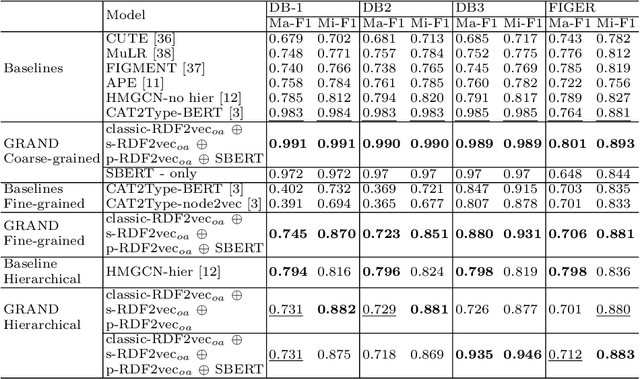
Abstract:The entity type information in Knowledge Graphs (KGs) such as DBpedia, Freebase, etc. is often incomplete due to automated generation or human curation. Entity typing is the task of assigning or inferring the semantic type of an entity in a KG. This paper presents \textit{GRAND}, a novel approach for entity typing leveraging different graph walk strategies in RDF2vec together with textual entity descriptions. RDF2vec first generates graph walks and then uses a language model to obtain embeddings for each node in the graph. This study shows that the walk generation strategy and the embedding model have a significant effect on the performance of the entity typing task. The proposed approach outperforms the baseline approaches on the benchmark datasets DBpedia and FIGER for entity typing in KGs for both fine-grained and coarse-grained classes. The results show that the combination of order-aware RDF2vec variants together with the contextual embeddings of the textual entity descriptions achieve the best results.
 Add to Chrome
Add to Chrome Add to Firefox
Add to Firefox Add to Edge
Add to Edge